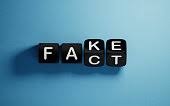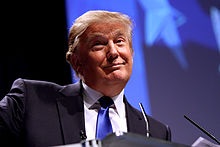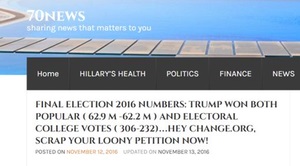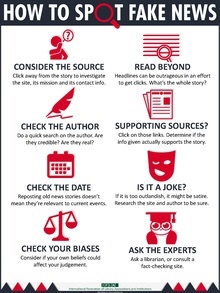|
|
| |
|
|
| |
|
|
|
|
| |
 |
| Graphic which shows
the fine line between fake and factual news. |
Fake News
Fake news is false or misleading information presented
as news. It often has the aim of damaging the reputation
of a person or entity, or making money through
advertising revenue. Media scholar Nolan Higdon has
offered a more broad definition of fake news as "false
or misleading content presented as news and communicated
in formats spanning spoken, written, printed,
electronic, and digital communication."
Once common in print, the prevalence of fake news has
increased with the rise of social media, especially the
Facebook News Feed. Political polarization, post-truth
politics, confirmation bias, and social media algorithms
have been implicated in the spread of fake news. It is
sometimes generated and propagated by hostile foreign
actors, particularly during elections. The use of
anonymously-hosted fake news websites has made it
difficult to prosecute sources of fake news for libel.
In some definitions, fake news includes satirical
articles misinterpreted as genuine, and articles that
employ sensationalist or clickbait headlines that are
not supported in the text. |
 |
| Donald Trump
frequently mentioned fake news on Twitter to
criticize the media in the United States,
including CNN and New York Times. |
Fake news can reduce the impact of real news by
competing with it; a Buzzfeed analysis found that the
top fake news stories about the 2016 U.S. presidential
election received more engagement on Facebook than top
stories from major media outlets. It also has the
potential to undermine trust in serious media coverage.
The term has at times been used to cast doubt upon
legitimate news, and former U.S. president Donald Trump
has been credited with popularizing the term by using it
to describe any negative press coverage of himself. It
has been increasingly criticized, due in part to Trump's
misuse, with the British government deciding to avoid
the term, as it is "poorly-defined" and "conflates a
variety of false information, from genuine error through
to foreign interference". |
 |
| Screenshot of a fake
news story, falsely stating Donald Trump won the
popular vote in the 2016 U.S. election. |
Definition
Fake news is a neologism. Fake news, or fake news
websites, have no basis in fact, but are presented as
being factually accurate. Media scholar Nolan Higdon has
argued that the definition of fake news has been applied
too narrowly to select mediums and political ideologies.
Fake news also refers to stories that are fabricated
that obtain little to no verifiable facts.
Michael Radutzky, a producer of CBS 60 Minutes, said his
show considers fake news to be "stories that are
probably false, have enormous traction [popular appeal]
in the culture, and are consumed by millions of people."
These stories are not only found in politics, but also
in areas like vaccination, stock values and nutrition.
He did not include news that is "invoked by politicians
against the media for stories that they don't like or
for comments that they don't like" as fake news. Guy
Campanile, also a 60 Minutes producer said, "What we are
talking about are stories that are fabricated out of
thin air. By most measures, deliberately, and by any
definition, that's a lie."
The intent and purpose of fake news is important. In
some cases, what appears to be fake news may be news
satire, which uses exaggeration and introduces
non-factual elements that are intended to amuse or make
a point, rather than to deceive. Propaganda can also be
fake news. Some researchers have highlighted that "fake
news" may be distinguished not just by the falsity of
its content, but also the "character of [its] online
circulation and reception". |
|
Types
Here are a few examples of fake news: |
- Clickbait
- Propaganda
- Satire/parody
- Sloppy journalism
- Misleading headings
- Manipulation
- Rumor Mill
- Misinformation
- Media Bias
- Audience Bias
- Content farm
|
|
These are features of fake news and may help to identify and
avoid instances of fake news. |
|
Identifying
The International Federation of Library Associations and
Institutions (IFLA) published a summary in diagram form
(pictured at right) to assist people in recognizing fake
news. Its main points are: |
- Consider the source (to understand
its mission and purpose)
- Read beyond the headline (to
understand the whole story)
- Check the authors (to see if they
are real and credible)
- Assess the supporting sources (to
ensure they support the claims)
- Check the date of publication (to
see if the story is relevant and up to date)
- Ask if it is a joke (to determine if
it is meant to be satire)
- Review your own biases (to see if
they are affecting your judgment)
- Ask experts (to get confirmation
from independent people with knowledge)
|
 |
| The roots of "fake
news" from UNESCO's World Trends Report. |
The International Fact-Checking Network (IFCN), launched in
2015, supports international collaborative efforts in
fact-checking, provides training, and has published a code
of principles. In 2017 it introduced an application and
vetting process for journalistic organisations. One of
IFCN's verified signatories, the independent, not-for-profit
media journal The Conversation, created a short animation
explaining its fact checking process, which involves "extra
checks and balances, including blind peer review by a second
academic expert, additional scrutiny and editorial
oversight".
Beginning in the 2017 school year, children in Taiwan study
a new curriculum designed to teach critical reading of
propaganda and the evaluation of sources. Called "media
literacy", the course provides training in journalism in the
new information society. |
|
 |
| Infographic How to
spot fake news published by the International
Federation of Library Associations and
Institutions. |
Detecting fake news online
Fake news has become increasingly prevalent over the
last few years, with over 100 incorrect articles and
rumors spread incessantly just with regard to the 2016
United States presidential election. These fake news
articles tend to come from satirical news websites or
individual websites with an incentive to propagate false
information, either as clickbait or to serve a purpose.
Since they typically hope to intentionally promote
incorrect information, such articles are quite difficult
to detect. Media scholar Nolan Higdon has argued that a
critical media literacy education focused on teaching
students how to detect fake news is the most effective
way for mitigating the pernicious influence of
propaganda. In his book "The Anatomy of Fake News: A
Critical News Education," Higdon offers a ten-step guide
for detecting fake news. When identifying a source of
information, one must look at many attributes, including
but not limited to the content of the email and social
media engagements. specifically, the language is
typically more inflammatory in fake news than real
articles, in part because the purpose is to confuse and
generate clicks. Furthermore, modeling techniques such
as n-gram encodings and bag of words have served as
other linguistic techniques to determine the legitimacy
of a news source. On top of that, researchers have
determined that visual-based cues also play a factor in
categorizing an article, specifically some features can
be designed to assess if a picture was legitimate and
provides more clarity on the news. There is also many
social context features that can play a role, as well as
the model of spreading the news. Websites such as "Snopes"
try to detect this information manually, while certain
universities are trying to build mathematical models to
do this themselves.
In social media
Fake news and disinformation is spread all over social
media, such as Twitter, everyday. More than 6.6 million
tweets linking to fake and conspiracy news publishers
around the 2016 campaign. Most News stories on Twitter
follow a statistically regular pattern. However many
fake news stories do not follow this pattern. Organized
blocks or accounts coordinate to create a longer
lifecycle for this fake news information. |
|
 Kiddle: Fake News Kiddle: Fake News
Wikipedia: Fake News |
 Wikipedia: Detecting fake news online Wikipedia: Detecting fake news online
Wikipedia: Fake news website
|
 Wikipedia: Fake news websites in the United States Wikipedia: Fake news websites in the United States
Wikipedia: Fake news in the United States
Wikipedia: Media bias in the United States |
|
|
|
|
|
|
|
|
|
|
|
|
|
|
|
|
Search Fun Easy English |
|
|
|
|
|
|
|
|
|
|
|
|
|
|
|
About
Contact
Copyright
Resources
Site Map |